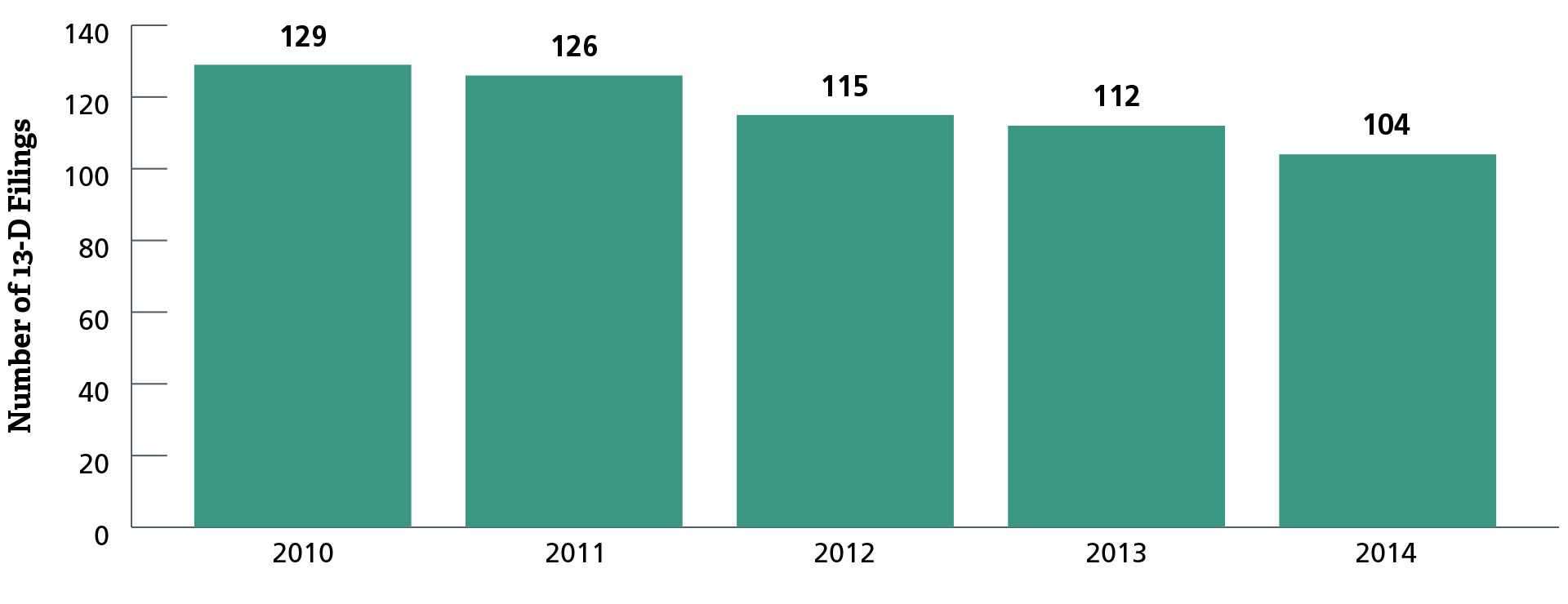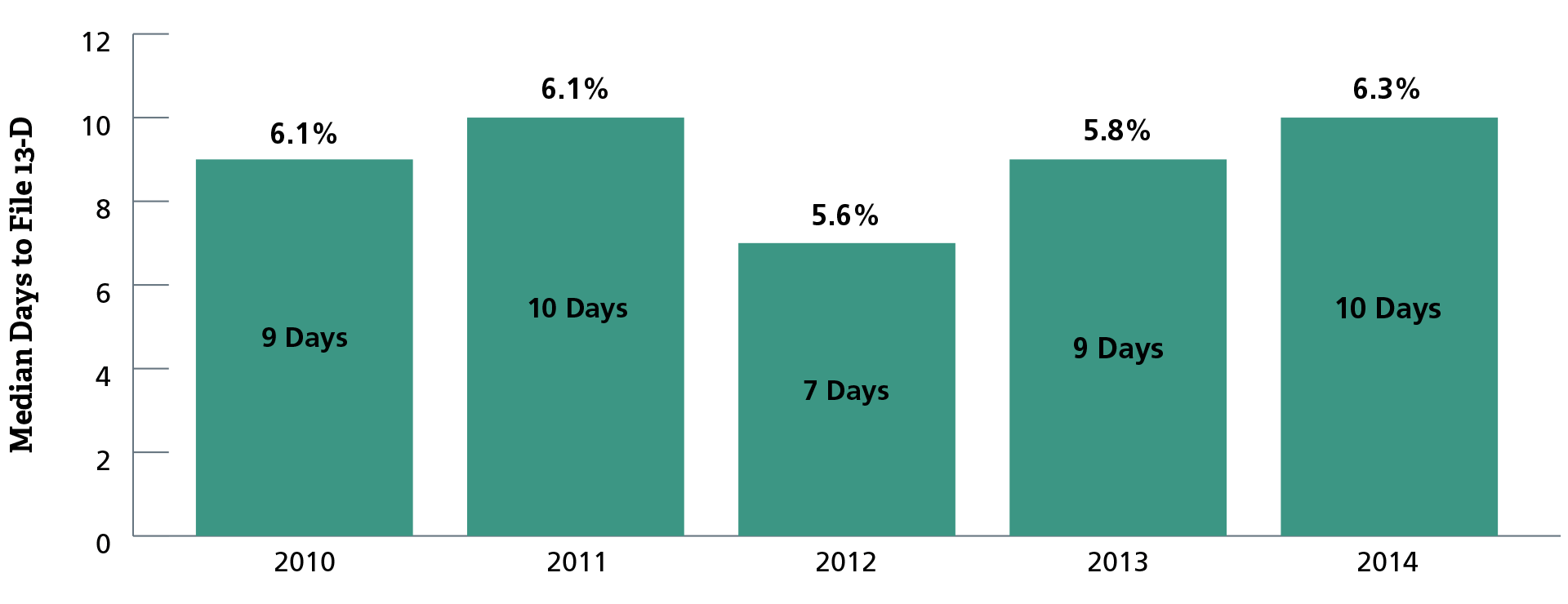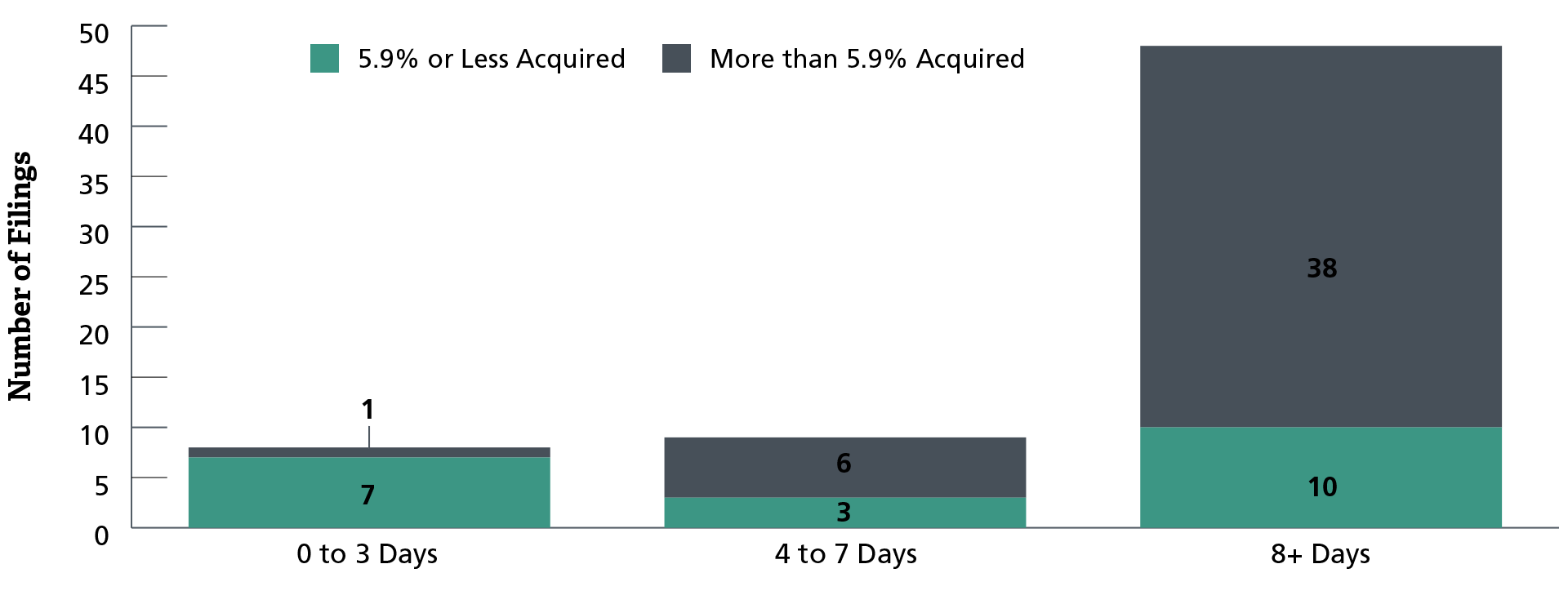-
Wolf Pack Activism: A Deeper Look
Recently, a lot of media attention has been devoted to the growth in hedge fund activism and the question of whether rules regarding disclosure should be changed with respect to the number of days within which active investors crossing the 5% shareholding threshold are required to file Form 13-D with the US Securities and Exchange Commission (SEC). In this discussion, we illustrate this growth in hedge fund activism (as shown in Chart 1, below) and different activist strategies. Although some hedge funds use the waiting period between the time that the Form 13-D disclosure requirement is triggered (by investors crossing the 5% threshold) and the actual filing of Form 13-D to make additional acquisitions, other hedge funds do not add significantly to their positions but still wait eight days or more prior to the 13-D filing (see Chart 2).
A review of the trading volume of stocks that are targeted by activists demonstrates that, on average, the trading volume during the waiting period is about one-and-a-half times higher than the targeted stock’s average trading volume.1 A jump in trading volume during the waiting period may be indicative of what has come to be known as “wolf packs” -- that is, activists or other hedge funds that are focused on a common target, but are not a part of a group pursuant to Section 13(d)(3) of the Securities Exchange Act of 1934. However, it is also likely that a part of the increase in trading volume observed during the waiting period could be driven by purchases made by an activist that ultimately does make the 13-D disclosure, rather than by a wolf pack. To isolate instances in which the increased trading volume is likely due to other activists -- who are members but not the leader of the wolf pack -- one would need to analyze the trading volume of targets where the activist filing the 13-D did not report a stake that is substantially higher than 5%. A review of the trading volume of targets of activism does seem to be consistent with the notion that a 13-D filing may be delayed in order to allow members of the wolf pack to accumulate a large position (see Chart 3).
Chart 1: 13-D Filings by Activist Hedge Funds2

Chart 1 shows that there were more than 100 13-D filings by activist hedge funds in each of the past 5 years. In this period, activist influence appears to have been on the rise. Not only has the success rate for proxy fights launched by activist hedge funds increased, but activists have also been targeting larger companies.
Chart 2: Characteristics of Activist Hedge Fund 13-D Filings2

Chart 2 shows that, typically, activists take around 10 days after crossing the 5% threshold to file Form 13-D with the SEC. This has remained relatively stable, despite a small dip in 2012. This chart also illustrates that, as of the date of the 13-D filing, the median shareholding by activists has remained relatively constant at approximately 6%.
Chart 3: Instances Where Excess Target Trading Volume during the Waiting Period Is 10% or More of the Target's Shares Outstanding2,3

Chart 3 sheds some light on activist strategies. In order to gain some insight with respect to wolf packs, we first isolate instances where the abnormal trading volume during the waiting period was more than 10% of the target firm’s shares outstanding. We then distribute 13-D filings across three buckets -- filings that were made within 3 days of crossing the 5% threshold, filings where the waiting period was between 4 and 7 days, and filings that were made 8 or more days after crossing the 5% threshold. The chart shows that there were 8 instances between 2010 and 2014 where the abnormal volume during the waiting period was at least 10% of the target’s shares outstanding and the 13-D filing was made within 3 days of crossing the 5% threshold. As expected, the number of instances where the abnormal trading volume during the waiting period exceeds 10% is greater when one focuses on 13-D filings made 8 or more days after crossing the threshold.
To analyze the extent to which the longer waiting period may reflect the time taken by activist hedge funds to accumulate a position, we further distribute the filers into two categories -- those who reported a position of 5.9% or less in the 13-D filing and those who reported a position of more than 5.9% (where 5.9% is the median stake disclosed by an activist in a 13-D filing during the five-year period ending in 2014). The data seem to be consistent with the notion that, in general, activists wait longer to file in order to accumulate a bigger position. Among the instances where the abnormal trading volume during the waiting period was more than 10% of the target firm’s shares outstanding, only one activist that reported a holding of more than 5.9% filed the 13-D within 3 days, while 38 activists that acquired more than 5.9% took 8 or more days to file a 13-D.
Finally, Chart 3 also shows that a number of activists chose to wait to file a 13-D even though they only accumulated less than 5.9% of the target’s shares outstanding. For example, there were ten instances where activists took at least 8 days to file a 13-D but reported a position of less than 5.9%, while during the waiting period, the abnormal trading volume was more than 10% of the target’s shares outstanding. This pattern seems consistent with the notion that certain activists wait to file a 13-D in order to enable members of a wolf pack to accumulate large positions. ■
Notes & Sources
- Normal trading volume of a stock is computed as the average daily trading volume during the 200-day period beginning from 220 days prior to the crossing of the 5% shareholding threshold to 21 days prior to the crossing the 5% threshold.
- Source: SEC Filings. Note: Includes only 13-D filings filed by companies classified as activist hedge funds (i.e. excluding filings made by corporations, closed-end funds, banks, insurance companies, or individuals).
- Note: Excess trading volume is defined as the trading volume during the waiting period minus the normal trading volume (where the normal trading volume is the average trading volume during the 200-day period beginning from 220 days prior to crossing the 5% threshold to 21 days prior to crossing the 5% threshold).
-
Gaurav Jetley is a Managing Principal in Analysis Group’s New York office. Xinyu Ji is a Principal in Analysis Group’s Boston office.
This feature appeared in the June 2015 Transaction & Governance Litigation Alert.

